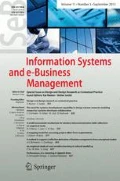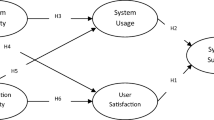Abstract
This paper examines the success of an e-learning system in a company from the perspective of employees by using a multimethod approach. For this purpose Moodle learning management system was used. The success of e-learning as an information system was evaluated using four constructs of the updated DeLone and McLean IS success model—system quality, use, user satisfaction and net benefits, and adding one more construct—user performance. In this research a combination of observation and survey as two different research methods was used, which allowed the new measure to be incorporated into the model. Empirical assessment was carried out by exploratory factor analysis, confirmatory factor analysis and structural equation modeling. The research model was found to be valid and reliable. The results provide an expanded understanding of the constructs that measure the success of an e-learning system, helping to more deeply understand the key success dimensions and their interrelationships. The implications of our work were discussed. The DeLone and McLean IS success model applied equally well. However, the use of observation as a method of data collection revealed the weaknesses of the original model.


Similar content being viewed by others
References
Ahire SL, Golhar DY, Waller MA (1996) Development and validation of TQM implementation constructs. Decis Sci 27:23–56. doi:10.1111/j.1540-5915.1996.tb00842.x
Armstrong CP, Sambamurthy V (1999) Information technology assimilation in firms: the influence of senior leadership and IT infrastructures. Inf Syst Res 10:304–327
Asparouhov T, Muthén B (2009) Exploratory structural equation modeling. Struct Equ Model A Multidiscip J 16:397–438. doi:10.1080/10705510903008204
Avouris NM, Dimitracopoulou A, Daskalaki S, Tselios NK (2001) Evaluation of distance-learning environments: impact of usability on student performance. Int J Educ Telecommun 7:355–378
Balaban I, Mu E, Divjak B (2013) Development of an electronic Portfolio system success model: an information systems approach. Comput Educ 60:396–411
Bartlett KR (2005) Survey research in organizations. In: Swanson RA, Holton EF (eds) Res. Organ. Found. Methods Inq. Berrett-Koehler, San Francisco, CA, pp 97–113
Benbasat I, Goldstein DK, Mead M (1987) The case research strategy in studies of information systems. MIS Q 11:369–386. doi:10.2307/248684
Bentler PM, Bonett DG (1980) Significance tests and goodness of fit in the analysis of covariance structures. Psychol Bull 88:588–606
Birnbaum MH (2004) Human research and data collection via the internet. Annu Rev Psychol 55:803–832
Chen H-J (2012) Clarifying the empirical connection of new entrants’ e-learning systems use to their job adaptation and their use patterns under the collective–individual training environment. Comput Educ 58:321–337
Creswell JW, Plano Clark VL (2011) Designing and conducting mixed methods research, 2nd ed. SAGE Publications, Thousand Oaks, CA
Davis FD (1989) Perceived usefulness, perceived ease of use, and user acceptance of information technology. MIS Q 13:319–340
Davis D, Golicic S, Boerstler C (2011) Benefits and challenges of conducting multiple methods research in marketing. J Acad Mark Sci 39:467–479. doi:10.1007/s11747-010-0204-7
Delic M, Radlovacki V, Kamberovic B et al (2013) Examining relationships between quality management and organisational performance in transitional economies. Total Qual Manag Bus Excell. doi:10.1080/14783363.2013.799331
DeLone W, McLean E (1992) Information systems success: the quest for the dependent variable. Inf Syst Res 3:60–95
DeLone W, McLean E (2003) The DeLone and McLean model of information systems success : a ten-year update. J Manag Inf Syst 19:9–31
DeRouin RE, Fritzsche BA, Salas E (2005) E-Learning in Organizations. J. Manage 31:920–940
Dillman DA (2007) Mail and internet surveys: the tailored design method, 2nd edn. John Wiley & Sons Inc, Hoboken
Eom S, Ashill NJ, Arbaugh JB, Stapleton JL (2012) The role of information technology in e-learning systems success. Hum Syst Manag 31:147–163. doi:10.3233/HSM-2012-0767
Escobar-Rodriguez T, Monge-Lozano P (2012) The acceptance of Moodle technology by business administration students. Comput Educ 58:1085–1093. doi:10.1016/j.compedu.2011.11.012
Garcia-Smith D, Effken JA (2013) Development and initial evaluation of the clinical information systems success model (CISSM). Int J Med Inform 82:539–552
Hair JF, Black WC, Babin BJ, Anderson RE (2009) Multivariate data analysis, 7th ed. Prentice Hall, Upper Saddle River, NJ
Hassanzadeh A, Kanaani F, Elahi S (2012) A model for measuring e-learning systems success in universities. Expert Syst Appl 39:10959–10966
Holsapple CW, Lee-Post A (2006) Defining, assessing, and promoting e-learning success: an information systems perspective. Decis Sci J Innov Educ 4:67–85
Hou C-K (2012) Examining the effect of user satisfaction on system usage and individual performance with business intelligence systems: an empirical study of Taiwan’s electronics industry. Int J Inf Manage 32:560–573
Hu L, Bentler PM (1999) Cutoff criteria for fit indexes in covariance structure analysis: conventional criteria versus new alternatives. Struct Equ Model A Multidiscip J 6:1–55. doi:10.1080/10705519909540118
Kaplan B, Duchon D (1988) Combining qualitative and quantitative methods in information systems research: a case study. MIS Q 12:571–586
Kirkpatrick DL, Kirkpatrick JD (2006) Evaluating training programs, 3rd edn. Berrett-Koehler Publishers, San Francisco
Kong SC (2011) An evaluation study of the use of a cognitive tool in a one-to-one classroom for promoting classroom-based dialogic interaction. Comput Educ 57:1851–1864. doi:10.1016/j.compedu.2011.04.008
Lee J-K, Lee W-K (2008) The relationship of e-Learner’s self-regulatory efficacy and perception of e-Learning environmental quality. Comput Human Behav 24:32–47. doi:10.1016/j.chb.2006.12.001
Lee M, Cheung C, Chen Z (2005) Acceptance of Internet-based learning medium: the role of extrinsic and intrinsic motivation. Inf Manag 42:1095–1104. doi:10.1016/j.im.2003.10.007
Lin H-F (2007) Measuring online learning systems success: applying the updated DeLone and McLean model. Cyberpsychol Behav 10:817–820
Lopez-Fernandez O, Rodriguez-Illera JL (2009) Investigating university students’ adaptation to a digital learner course portfolio. Comput Educ 52:608–616. doi:10.1016/j.compedu.2008.11.003
Markus ML, Tanis C (2000) The enterprise system experience—from adoption to success. In: Zmud R (ed) Fram. Domains IT Manag. Proj. Futur. Through Past. Pinnaflex Educational Resources inc., Cincinnati, pp 173–207
Martín-Blas T, Serrano-Fernández A (2009) The role of new technologies in the learning process: moodle as a teaching tool in Physics. Comput Educ 52:35–44
Mason RO (1978) Measuring information output: A communication systems approach. Inf Manag 1:219–234. doi:10.1016/0378-7206(78)90028-9
McGill T, Hobbs V, Klobas J (2003) User developed applications and information systems success. Inf Resour Manag J 16:24–45
Means B, Toyama Y, Murphy R, Bakia M, Jones K (2010) Evaluation of evidence-based practices in online learning: a meta-analysis and review of online learning studies. Washington, DC: US Department of Education, Office of Planning, Evaluation, and Policy Development
Mingers J (2001) Combining IS research methods: towards a pluralist methodology. Inf Syst Res 12:240
Mingers J (2003) The paucity of multimethod research: a review of the information systems literature. Inf Syst J 13:233–249
Nunnally J, Bernstein H (1994) Psychometric theory. McGraw-Hill, New York
Ozkan S, Koseler R (2009) Multi-dimensional students’ evaluation of e-learning systems in the higher education context: an empirical investigation. Comput Educ 53:1285–1296
Petter S, McLean ER (2009) A meta-analytic assessment of the DeLone and McLean IS success model: an examination of IS success at the individual level. Inf Manag 46:159–166
Petter S, DeLone W, McLean E (2008) Measuring information systems success: models, dimensions, measures, and interrelationships. Eur J Inf Syst 17:236–263. doi:10.1057/ejis.2008.15
Pitt LF, Watson RT, Kavan CB (1995) Service quality: a measure of information systems effectiveness. MIS Q 19:173–187
Rice W (2006) Moodle e-learning course development. Packt Publishing Ltd., Birmingham
Roca JC, Chiu C-M, Martínez FJ (2006) Understanding e-learning continuance intention: an extension of the technology acceptance model. Int J Hum Comput Stud 64:683–696. doi:10.1016/j.ijhcs.2006.01.003
Romero C, Ventura S, García E (2008) Data mining in course management systems: Moodle case study and tutorial. Comput Educ 51:368–384. doi:10.1016/j.compedu.2007.05.016
Schmitt TA (2011) Current methodological considerations in exploratory and confirmatory factor analysis. J Psychoeduc Assess 29:304–321. doi:10.1177/0734282911406653
Seddon PB (1997) A respecification and extension of the DeLone and McLean model of IS success. Inf Syst Res 8:240–253
Seddon PB, Kiew M-Y (1996) A partial test and development of Delone and Mclean’s model of IS success. Australas J Inf Syst 4:90–109. doi:10.3127/ajis.v4i1.379
Shannon CE, Weaver W (1949) The mathematical theory of communication. University of Illinois Press, Urbana
Urbach N, Smolnik S, Riempp G (2009) The state of research on information systems success. Bus Inf Syst Eng 1:315–325. doi:10.1007/s12599-009-0059-y
Urbach N, Smolnik S, Riempp G (2010) An empirical investigation of employee portal success. J Strateg Inf Syst 19:184–206
Venkatesh V, Davis FD (2000) A theoretical extension of the technology acceptance model: four longitudinal field studies. Manage Sci 46:186
Venkatesh V, Morris MG, Davis GB, Davis FD (2003) User acceptance of information technology: toward a unified view. MIS Q 27:425–478
Venkatesh V, Brown SA, Bala H (2013) Bridging the qualitative-quantitative divide: guidelines for conducting mixed methods research in information systems. MIS Q 37:21–54
Wang Y-S (2003) Assessment of learner satisfaction with asynchronous electronic learning systems. Inf Manag 41:75–86. doi:10.1016/S0378-7206(03)00028-4
Wang Y-S, Liao Y-W (2008) Assessing eGovernment systems success: a validation of the DeLone and McLean model of information systems success. Gov Inf Q 25:717–733
Wang Y-S, Wang H-Y, Shee DY (2007) Measuring e-learning systems success in an organizational context: scale development and validation. Comput Hum Behav 23:1792–1808
Wu J-H, Wang Y-M (2006) Measuring KMS success: a respecification of the DeLone and McLean’s model. Inf Manag 43:728–739
Zhang P (2008) Motivational affordances: fundamental reasons for ICT design and use. Commun ACM 51:145–147. doi:10.1145/1400214.1400244
Zhang D, Nunamaker J (2003) Powering e-learning in the new millennium: an overview of e-learning and enabling technology. Inf Syst Front 5:207–218. doi:10.1023/A:1022609809036
Author information
Authors and Affiliations
Corresponding author
Appendix: Survey items used in this study
Appendix: Survey items used in this study
System quality
- SQ1:
-
The eGovernment system is user friendly
- SQ2:
-
The eGovernment system is easy to use
User satisfaction
- US1:
-
You are satisfied with the content of the e-learning system
- US2:
-
You are satisfied with the instructions on how to use the e-learning system
- US3:
-
You are satisfied with the e-learning environment
- US4:
-
Overall, you are satisfied with this e-learning system
Net benefits
- NB1:
-
The e-learning system helped me to improve my knowledge
- NB2:
-
The e-learning system helped me to improve my attitude towards the organization
Note This appendix presents only survey items. Observation items are not presented here.
Rights and permissions
About this article
Cite this article
Marjanovic, U., Delić, M. & Lalic, B. Developing a model to assess the success of e-learning systems: evidence from a manufacturing company in transitional economy. Inf Syst E-Bus Manage 14, 253–272 (2016). https://doi.org/10.1007/s10257-015-0282-7
Received:
Revised:
Accepted:
Published:
Issue Date:
DOI: https://doi.org/10.1007/s10257-015-0282-7




